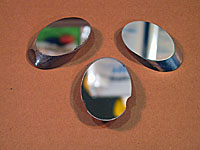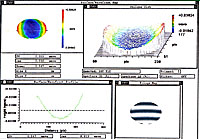

The Diagonal Mirror

1.3, 1.52 and 1.3 Inches
The Diagonal Mirror, also known as the Secondary Mirror, is used to bend the light cone from the primary mirror 90° towards the side of the tube and into the focuser and eyepiece. The diagonal is positioned in the center of the tube under the focuser at a 45° angle to the main optical axis of the telescope.
On this page we will talk about the mirror itself; on the next page we will talk about the parts that hold it in position in the center of the tube.
The shape of a diagonal mirror is an ellipse (oval), the shape a circle becomes when it is tilted back at an angle. Ellipses have a major (long) and minor (short) axis, which is the longest and shortest diameters of the ellipse. By convention, 45° mirror diagonals are specified by their minor axis size. As we have noted earlier, a small set of standard sizes are available for purchase, and these cover the most common needs of telescope builders.
Make or Buy?
The vast majority of telescope makers buy their diagonal mirrors. While we advocate making your primary mirror, making an optically flat surface is a very challenging project, as is testing it without a reference flat. Buy it.
Size
For the 'small' diagonals we are interested in, the standard sizes are 0.75, 1.00, 1.30, 1.52, 1.83 and 2.14 inches (minor axis). On the Design Page, we talked about the conflicting requirements of making your diagonal large enough to reflect the entire light cone, but keep it as small as possible to not 'shade' too much of the primary mirror.
Quality

Because the image your telescope forms is degraded by every optical surface it encounters, it is not uncommon for a telescope with a high quality primary mirror to produce poor images because of a low quality diagonal. Because it is generally easier to make smaller optics more accurately than large optics, you should be able to purchase a diagonal that is of better quality than your primary mirror. Of course, you need to balance the quality level with the cost.
Remember that vendors specify surface accuracy of their mirrors, that is what they can measure directly and the number can often look enticingly small. Reflected light is degraded by twice the surface accuracy, so a 1/10 wave peak-to-valley surface accuracy mirror (at approximately 90° light incidence, as a primary mirror would encounter) produces a 1/5 wave error in the light cone. This very close to the ¼ wave minimum error we have strived for over our entire telescope system, and it is likely that if your primary is close to ¼ wave, in combination with the diagonal your system could easily exceed the limit (we are intentionally being a bit vague here, because it is also possible the errors in your two mirrors could possibly cancel out, although that would be extremely unlikely - it is much more likely they will be additive).
We would suggest a 1/15 wave surface accuracy as a minimum (which means 1/7.5 wave on the reflected light); 1/20 wave if available and affordable would be better.
Glass Type
We discussed Glass Types on the Primary Mirror Cell page, and we won't repeat that here. Another excellent glass type available for diagonal mirrors in smaller sizes is fused silica, which is typically smoother than Pyrex and has lower thermal expansion. So look for either fused silica or Pyrex as a glass type.
Coatings
We discussed Coatings on the Primary Mirror Cell page, for both the primary and diagonal, and will not repeat that discussion here. We will opt for enhanced coatings on our diagonal, because the benefit is available at a small incremental cost.
What We Bought
We bought a 1.30 inch minor axis diagonal mirror made of Pyrex glass with enhanced (96-98%) coatings. The vendor we used offers 1/18, 1/20 and 1/30 wave surface accuracy, and we selected the 1/18 wave quality level. In 2010, this cost us $59.99 plus shipping. The vendor provided the individual results from their interferometric testing and it looks to be right on spec at 0.055 waves surface accuracy peak-to-valley. Check our Links Page under Secondary & Diagonal Mirrors to locate a vendor (the one we used is listed there).
Previous: Installing a Focuser on the Tube Next:
Spiders, Vanes & Stalks
Back to the Build a Dobsonian Master Index